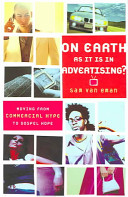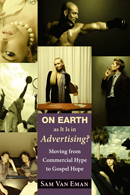Sam Van Eman: On Earth as It Is In Advertising

The 2005 cover from Brazos Press
Sam Van Eman, On Earth as It Is In Advertising: Moving From Commercial Hype to Gospel Hope (Grand Rapids: Brazos Press, 2005), 191 pages.
Introduction
Advertising is one of the most powerful forces to be reckoned with in today’s society. Thanks to modern technology, it is even stronger and more intrusive as it frequently delivers self-centered messages and half truths through different media 24 hours a day. Because of its ever-growing presence in homes across the United States and around the world, the reality of advertising poses a number of challenges for the Christian.
Van Eman is a staff resource specialist with the Coalition for Christian Outreach. In his new book, he contends that when advertising is unchecked and received without any filtering, it feeds the viewer (or reader) a steady stream of worldly-based ideas that often contradict the biblical teachings of sacrifice.
In other ways, Van Eman believes that commercial advertising presents a false gospel—one that appears to offer truth but in reality offers a message based on greed. The problem, he suggests, is only compounded when Christians spend more time watching movies (or television), and thereby consume more of the worldly messages than Scripture. Whenever that happens, “we lose focus on God, which means that everything we see is from a blurred point of view” (p. 10).
Van Eman warns that when Christians expose themselves “mindlessly to popular culture,” they “interpret little of it wisely and permit most of what is advertised to leave reside on [their] consciousness” (p. 15).
An overview

The cover from the 2010 re-release from Wipf & Stock.
Van Eman begins his discussion with an explanation of what he calls, “SimGospel.” The term is defined as “all messages that simulate the biblical narrative through advertising and popular media for the purpose of selling products and ideas” (p. 3). The idea comes from the computer game, “SimCity” where players can create and govern a simulated city. Hence “SimGospel,” is an imitated means to self-establishment (p. 20). An example of that may be seen in the story of Adam and Eve in the Garden of Eden, where they bought into the message of the serpent to become rulers of their own world.
Van Eman divides his discussion into three parts. In the first part, he addresses “Who Am I?” He compares what the Bible teaches about human nature with the messages of the SimGospel from popular culture and advertising. He also notes what the Bible and the SimGospel have to say about the needs of humanity.
In the second part, Van Eman discusses, “Who Is My Neighbor?” Again, he makes a striking comparison of what the Bible teaches and what the SimGospel teaches. He stresses the need for the church to remember the poor and anyone in need. He also explains how the church may neglect its true neighbors and thereby misplace its priorities.
Category: Living the Faith, Summer 2007


